Automation at Caltex: Analyzing the Future of Work Dynamics
VerifiedAdded on 2023/06/10
|12
|2573
|191
Essay
AI Summary
This essay examines the future of work, focusing on the potential impact of automation on Caltex, a petroleum brand of Chevron Corporation in Singapore. It reviews literature on technological unemployment, considering both opportunities and constraints, and discusses the theoretical and real-life applications of automation. The essay develops scenarios relevant to Caltex, highlighting the business relevance of automation in areas such as petrol/diesel filling, billing systems, and data generation. It assesses Caltex's resource capabilities and competencies to support the automation process and concludes with recommendations for change, including staff training and monitoring the impact of new technologies. The analysis suggests a future where Caltex integrates both manual and automated work, potentially reducing staffing needs and improving efficiency and customer satisfaction.
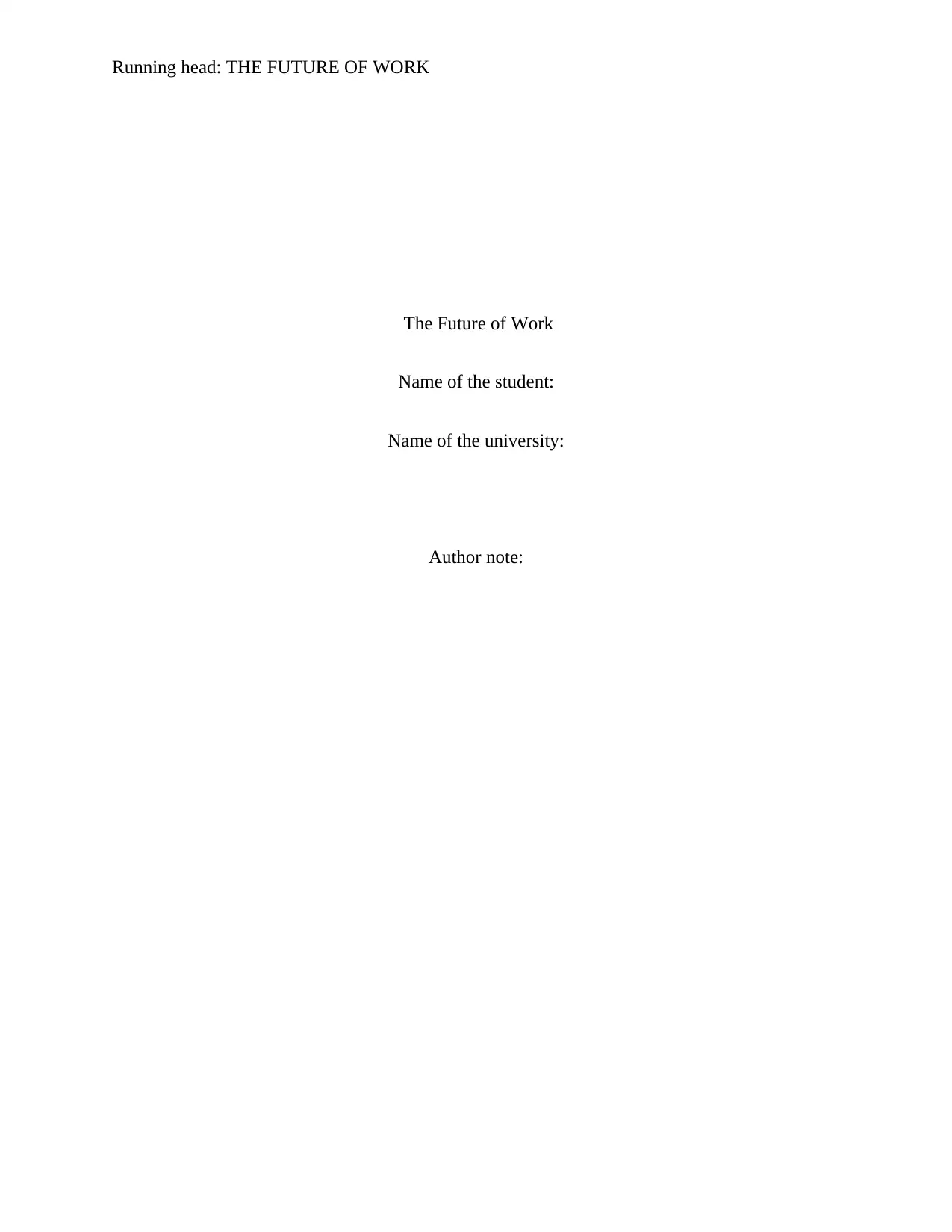
Running head: THE FUTURE OF WORK
The Future of Work
Name of the student:
Name of the university:
Author note:
The Future of Work
Name of the student:
Name of the university:
Author note:
Paraphrase This Document
Need a fresh take? Get an instant paraphrase of this document with our AI Paraphraser
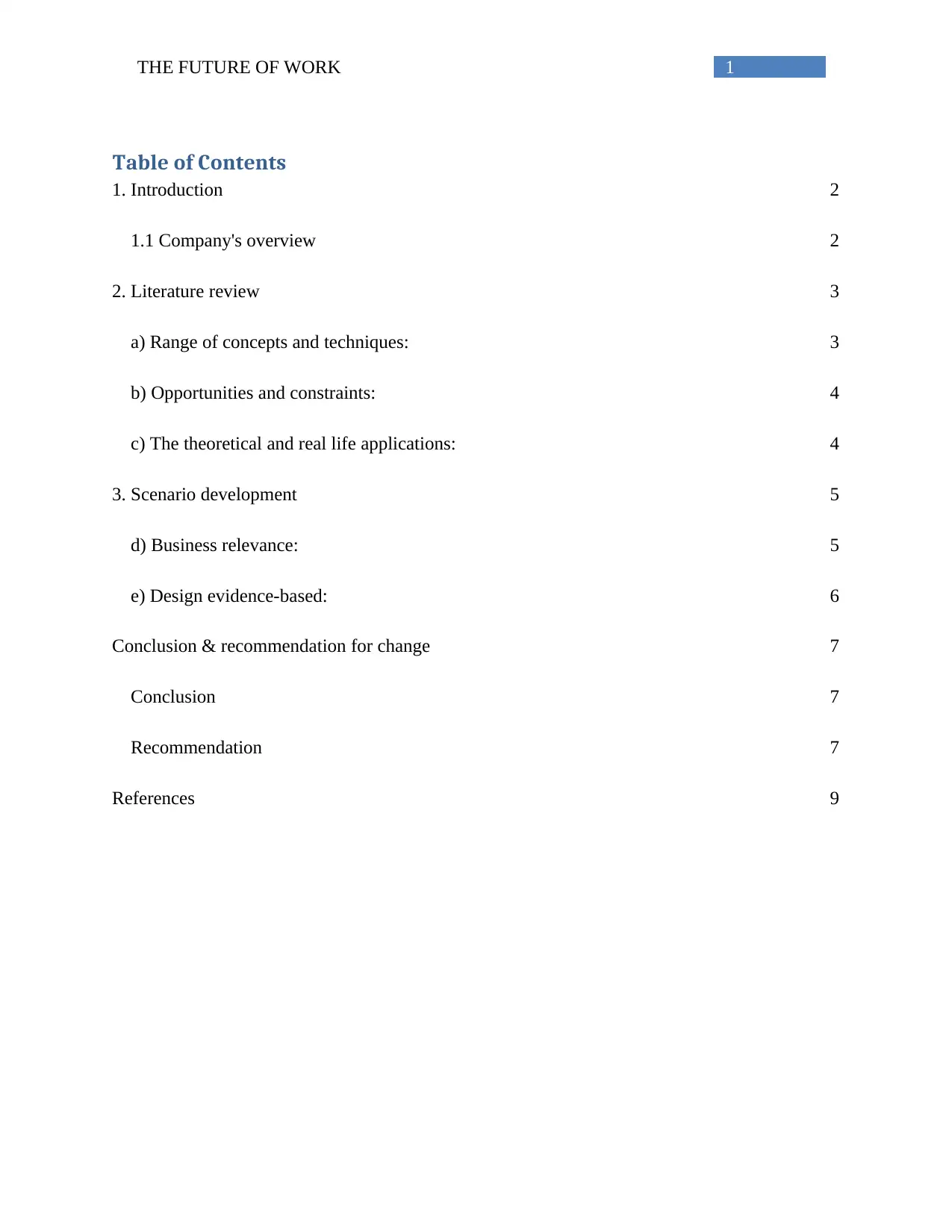
1THE FUTURE OF WORK
Table of Contents
1. Introduction 2
1.1 Company's overview 2
2. Literature review 3
a) Range of concepts and techniques: 3
b) Opportunities and constraints: 4
c) The theoretical and real life applications: 4
3. Scenario development 5
d) Business relevance: 5
e) Design evidence-based: 6
Conclusion & recommendation for change 7
Conclusion 7
Recommendation 7
References 9
Table of Contents
1. Introduction 2
1.1 Company's overview 2
2. Literature review 3
a) Range of concepts and techniques: 3
b) Opportunities and constraints: 4
c) The theoretical and real life applications: 4
3. Scenario development 5
d) Business relevance: 5
e) Design evidence-based: 6
Conclusion & recommendation for change 7
Conclusion 7
Recommendation 7
References 9
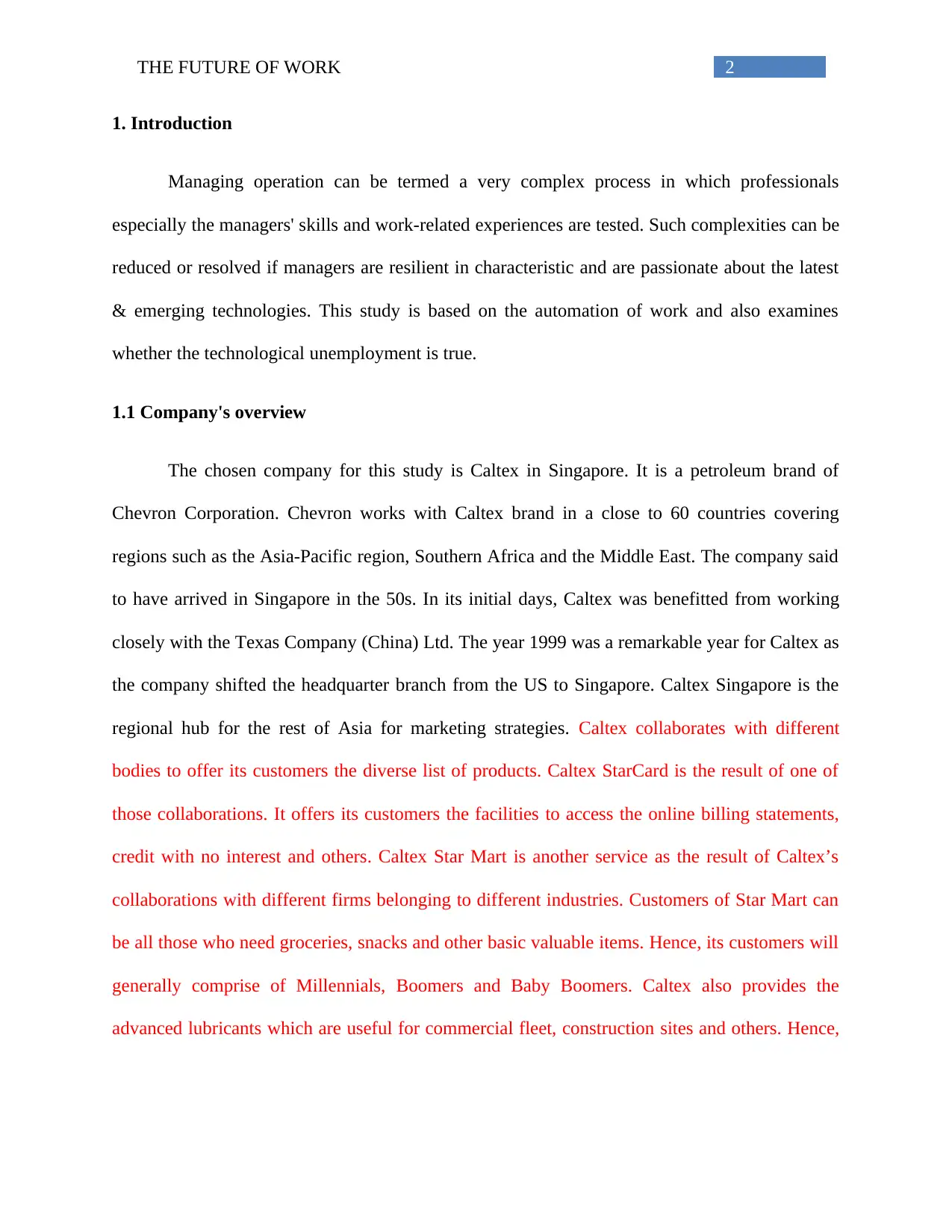
2THE FUTURE OF WORK
1. Introduction
Managing operation can be termed a very complex process in which professionals
especially the managers' skills and work-related experiences are tested. Such complexities can be
reduced or resolved if managers are resilient in characteristic and are passionate about the latest
& emerging technologies. This study is based on the automation of work and also examines
whether the technological unemployment is true.
1.1 Company's overview
The chosen company for this study is Caltex in Singapore. It is a petroleum brand of
Chevron Corporation. Chevron works with Caltex brand in a close to 60 countries covering
regions such as the Asia-Pacific region, Southern Africa and the Middle East. The company said
to have arrived in Singapore in the 50s. In its initial days, Caltex was benefitted from working
closely with the Texas Company (China) Ltd. The year 1999 was a remarkable year for Caltex as
the company shifted the headquarter branch from the US to Singapore. Caltex Singapore is the
regional hub for the rest of Asia for marketing strategies. Caltex collaborates with different
bodies to offer its customers the diverse list of products. Caltex StarCard is the result of one of
those collaborations. It offers its customers the facilities to access the online billing statements,
credit with no interest and others. Caltex Star Mart is another service as the result of Caltex’s
collaborations with different firms belonging to different industries. Customers of Star Mart can
be all those who need groceries, snacks and other basic valuable items. Hence, its customers will
generally comprise of Millennials, Boomers and Baby Boomers. Caltex also provides the
advanced lubricants which are useful for commercial fleet, construction sites and others. Hence,
1. Introduction
Managing operation can be termed a very complex process in which professionals
especially the managers' skills and work-related experiences are tested. Such complexities can be
reduced or resolved if managers are resilient in characteristic and are passionate about the latest
& emerging technologies. This study is based on the automation of work and also examines
whether the technological unemployment is true.
1.1 Company's overview
The chosen company for this study is Caltex in Singapore. It is a petroleum brand of
Chevron Corporation. Chevron works with Caltex brand in a close to 60 countries covering
regions such as the Asia-Pacific region, Southern Africa and the Middle East. The company said
to have arrived in Singapore in the 50s. In its initial days, Caltex was benefitted from working
closely with the Texas Company (China) Ltd. The year 1999 was a remarkable year for Caltex as
the company shifted the headquarter branch from the US to Singapore. Caltex Singapore is the
regional hub for the rest of Asia for marketing strategies. Caltex collaborates with different
bodies to offer its customers the diverse list of products. Caltex StarCard is the result of one of
those collaborations. It offers its customers the facilities to access the online billing statements,
credit with no interest and others. Caltex Star Mart is another service as the result of Caltex’s
collaborations with different firms belonging to different industries. Customers of Star Mart can
be all those who need groceries, snacks and other basic valuable items. Hence, its customers will
generally comprise of Millennials, Boomers and Baby Boomers. Caltex also provides the
advanced lubricants which are useful for commercial fleet, construction sites and others. Hence,
⊘ This is a preview!⊘
Do you want full access?
Subscribe today to unlock all pages.

Trusted by 1+ million students worldwide
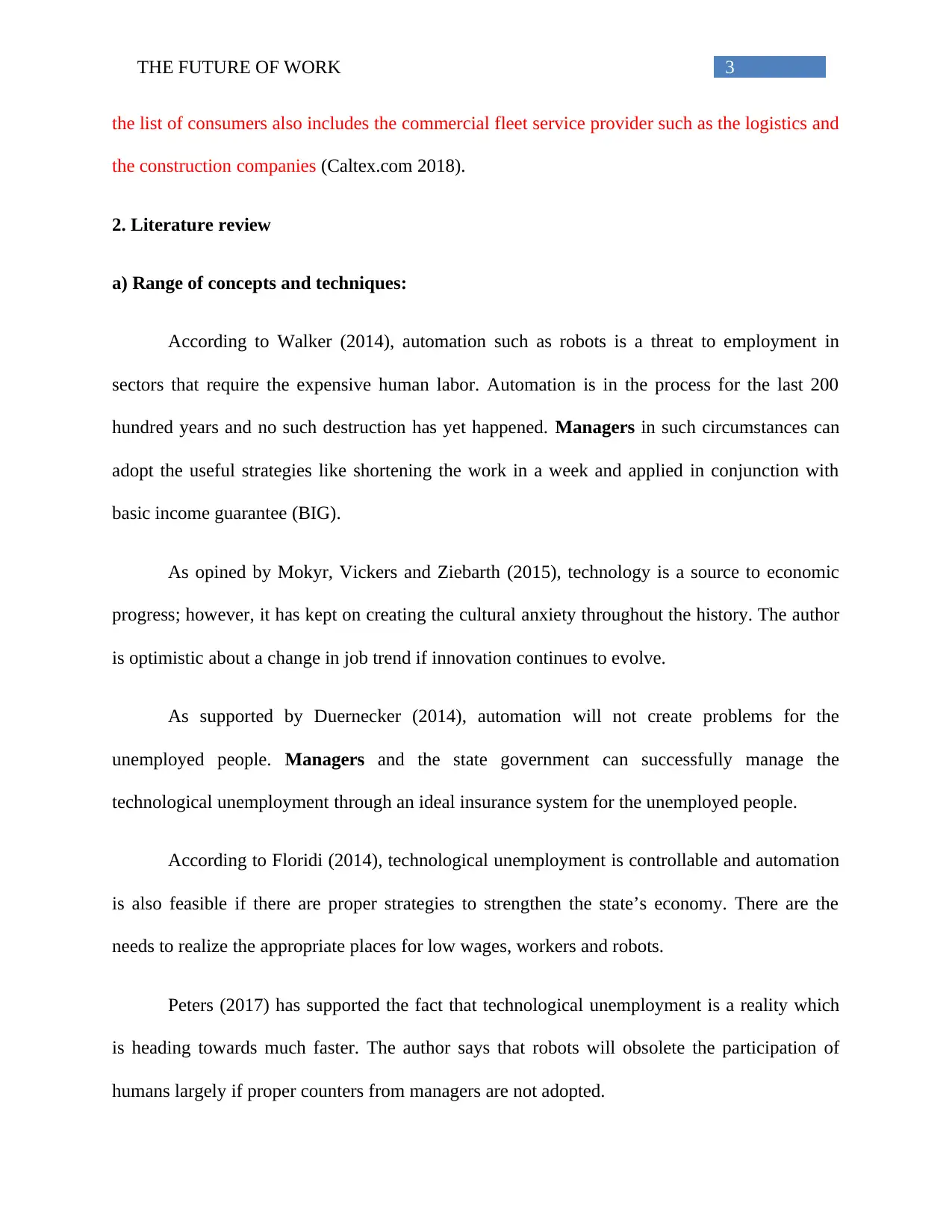
3THE FUTURE OF WORK
the list of consumers also includes the commercial fleet service provider such as the logistics and
the construction companies (Caltex.com 2018).
2. Literature review
a) Range of concepts and techniques:
According to Walker (2014), automation such as robots is a threat to employment in
sectors that require the expensive human labor. Automation is in the process for the last 200
hundred years and no such destruction has yet happened. Managers in such circumstances can
adopt the useful strategies like shortening the work in a week and applied in conjunction with
basic income guarantee (BIG).
As opined by Mokyr, Vickers and Ziebarth (2015), technology is a source to economic
progress; however, it has kept on creating the cultural anxiety throughout the history. The author
is optimistic about a change in job trend if innovation continues to evolve.
As supported by Duernecker (2014), automation will not create problems for the
unemployed people. Managers and the state government can successfully manage the
technological unemployment through an ideal insurance system for the unemployed people.
According to Floridi (2014), technological unemployment is controllable and automation
is also feasible if there are proper strategies to strengthen the state’s economy. There are the
needs to realize the appropriate places for low wages, workers and robots.
Peters (2017) has supported the fact that technological unemployment is a reality which
is heading towards much faster. The author says that robots will obsolete the participation of
humans largely if proper counters from managers are not adopted.
the list of consumers also includes the commercial fleet service provider such as the logistics and
the construction companies (Caltex.com 2018).
2. Literature review
a) Range of concepts and techniques:
According to Walker (2014), automation such as robots is a threat to employment in
sectors that require the expensive human labor. Automation is in the process for the last 200
hundred years and no such destruction has yet happened. Managers in such circumstances can
adopt the useful strategies like shortening the work in a week and applied in conjunction with
basic income guarantee (BIG).
As opined by Mokyr, Vickers and Ziebarth (2015), technology is a source to economic
progress; however, it has kept on creating the cultural anxiety throughout the history. The author
is optimistic about a change in job trend if innovation continues to evolve.
As supported by Duernecker (2014), automation will not create problems for the
unemployed people. Managers and the state government can successfully manage the
technological unemployment through an ideal insurance system for the unemployed people.
According to Floridi (2014), technological unemployment is controllable and automation
is also feasible if there are proper strategies to strengthen the state’s economy. There are the
needs to realize the appropriate places for low wages, workers and robots.
Peters (2017) has supported the fact that technological unemployment is a reality which
is heading towards much faster. The author says that robots will obsolete the participation of
humans largely if proper counters from managers are not adopted.
Paraphrase This Document
Need a fresh take? Get an instant paraphrase of this document with our AI Paraphraser
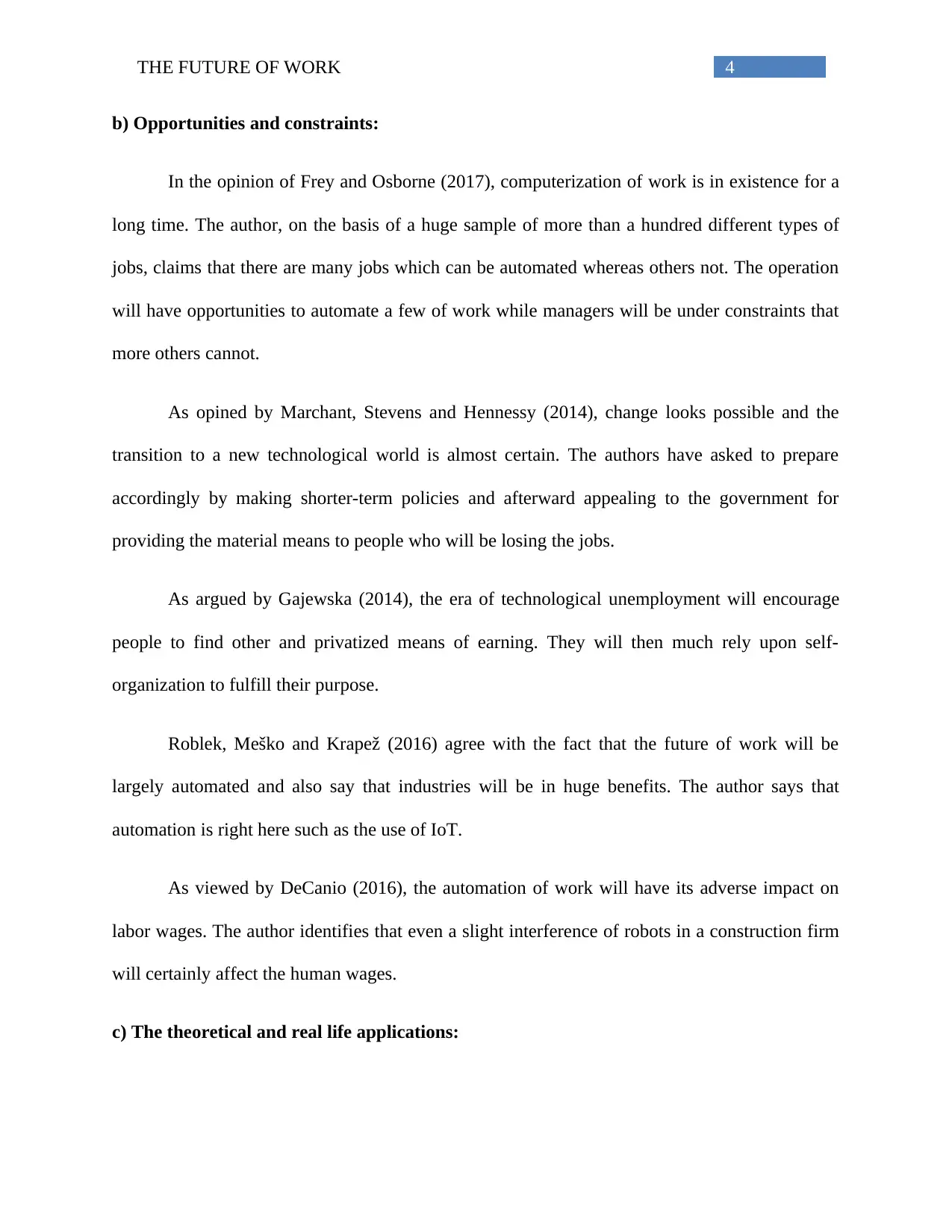
4THE FUTURE OF WORK
b) Opportunities and constraints:
In the opinion of Frey and Osborne (2017), computerization of work is in existence for a
long time. The author, on the basis of a huge sample of more than a hundred different types of
jobs, claims that there are many jobs which can be automated whereas others not. The operation
will have opportunities to automate a few of work while managers will be under constraints that
more others cannot.
As opined by Marchant, Stevens and Hennessy (2014), change looks possible and the
transition to a new technological world is almost certain. The authors have asked to prepare
accordingly by making shorter-term policies and afterward appealing to the government for
providing the material means to people who will be losing the jobs.
As argued by Gajewska (2014), the era of technological unemployment will encourage
people to find other and privatized means of earning. They will then much rely upon self-
organization to fulfill their purpose.
Roblek, Meško and Krapež (2016) agree with the fact that the future of work will be
largely automated and also say that industries will be in huge benefits. The author says that
automation is right here such as the use of IoT.
As viewed by DeCanio (2016), the automation of work will have its adverse impact on
labor wages. The author identifies that even a slight interference of robots in a construction firm
will certainly affect the human wages.
c) The theoretical and real life applications:
b) Opportunities and constraints:
In the opinion of Frey and Osborne (2017), computerization of work is in existence for a
long time. The author, on the basis of a huge sample of more than a hundred different types of
jobs, claims that there are many jobs which can be automated whereas others not. The operation
will have opportunities to automate a few of work while managers will be under constraints that
more others cannot.
As opined by Marchant, Stevens and Hennessy (2014), change looks possible and the
transition to a new technological world is almost certain. The authors have asked to prepare
accordingly by making shorter-term policies and afterward appealing to the government for
providing the material means to people who will be losing the jobs.
As argued by Gajewska (2014), the era of technological unemployment will encourage
people to find other and privatized means of earning. They will then much rely upon self-
organization to fulfill their purpose.
Roblek, Meško and Krapež (2016) agree with the fact that the future of work will be
largely automated and also say that industries will be in huge benefits. The author says that
automation is right here such as the use of IoT.
As viewed by DeCanio (2016), the automation of work will have its adverse impact on
labor wages. The author identifies that even a slight interference of robots in a construction firm
will certainly affect the human wages.
c) The theoretical and real life applications:
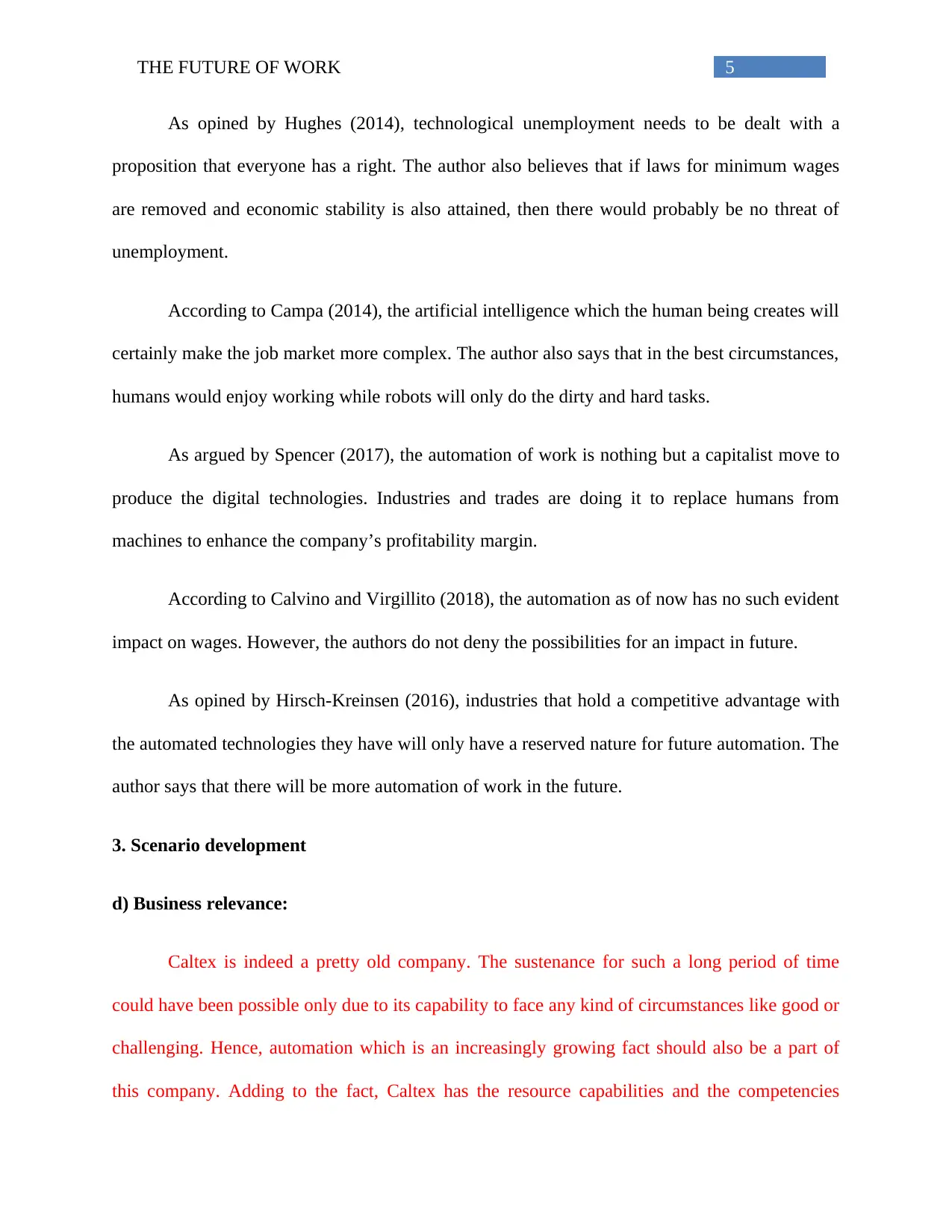
5THE FUTURE OF WORK
As opined by Hughes (2014), technological unemployment needs to be dealt with a
proposition that everyone has a right. The author also believes that if laws for minimum wages
are removed and economic stability is also attained, then there would probably be no threat of
unemployment.
According to Campa (2014), the artificial intelligence which the human being creates will
certainly make the job market more complex. The author also says that in the best circumstances,
humans would enjoy working while robots will only do the dirty and hard tasks.
As argued by Spencer (2017), the automation of work is nothing but a capitalist move to
produce the digital technologies. Industries and trades are doing it to replace humans from
machines to enhance the company’s profitability margin.
According to Calvino and Virgillito (2018), the automation as of now has no such evident
impact on wages. However, the authors do not deny the possibilities for an impact in future.
As opined by Hirsch-Kreinsen (2016), industries that hold a competitive advantage with
the automated technologies they have will only have a reserved nature for future automation. The
author says that there will be more automation of work in the future.
3. Scenario development
d) Business relevance:
Caltex is indeed a pretty old company. The sustenance for such a long period of time
could have been possible only due to its capability to face any kind of circumstances like good or
challenging. Hence, automation which is an increasingly growing fact should also be a part of
this company. Adding to the fact, Caltex has the resource capabilities and the competencies
As opined by Hughes (2014), technological unemployment needs to be dealt with a
proposition that everyone has a right. The author also believes that if laws for minimum wages
are removed and economic stability is also attained, then there would probably be no threat of
unemployment.
According to Campa (2014), the artificial intelligence which the human being creates will
certainly make the job market more complex. The author also says that in the best circumstances,
humans would enjoy working while robots will only do the dirty and hard tasks.
As argued by Spencer (2017), the automation of work is nothing but a capitalist move to
produce the digital technologies. Industries and trades are doing it to replace humans from
machines to enhance the company’s profitability margin.
According to Calvino and Virgillito (2018), the automation as of now has no such evident
impact on wages. However, the authors do not deny the possibilities for an impact in future.
As opined by Hirsch-Kreinsen (2016), industries that hold a competitive advantage with
the automated technologies they have will only have a reserved nature for future automation. The
author says that there will be more automation of work in the future.
3. Scenario development
d) Business relevance:
Caltex is indeed a pretty old company. The sustenance for such a long period of time
could have been possible only due to its capability to face any kind of circumstances like good or
challenging. Hence, automation which is an increasingly growing fact should also be a part of
this company. Adding to the fact, Caltex has the resource capabilities and the competencies
⊘ This is a preview!⊘
Do you want full access?
Subscribe today to unlock all pages.

Trusted by 1+ million students worldwide
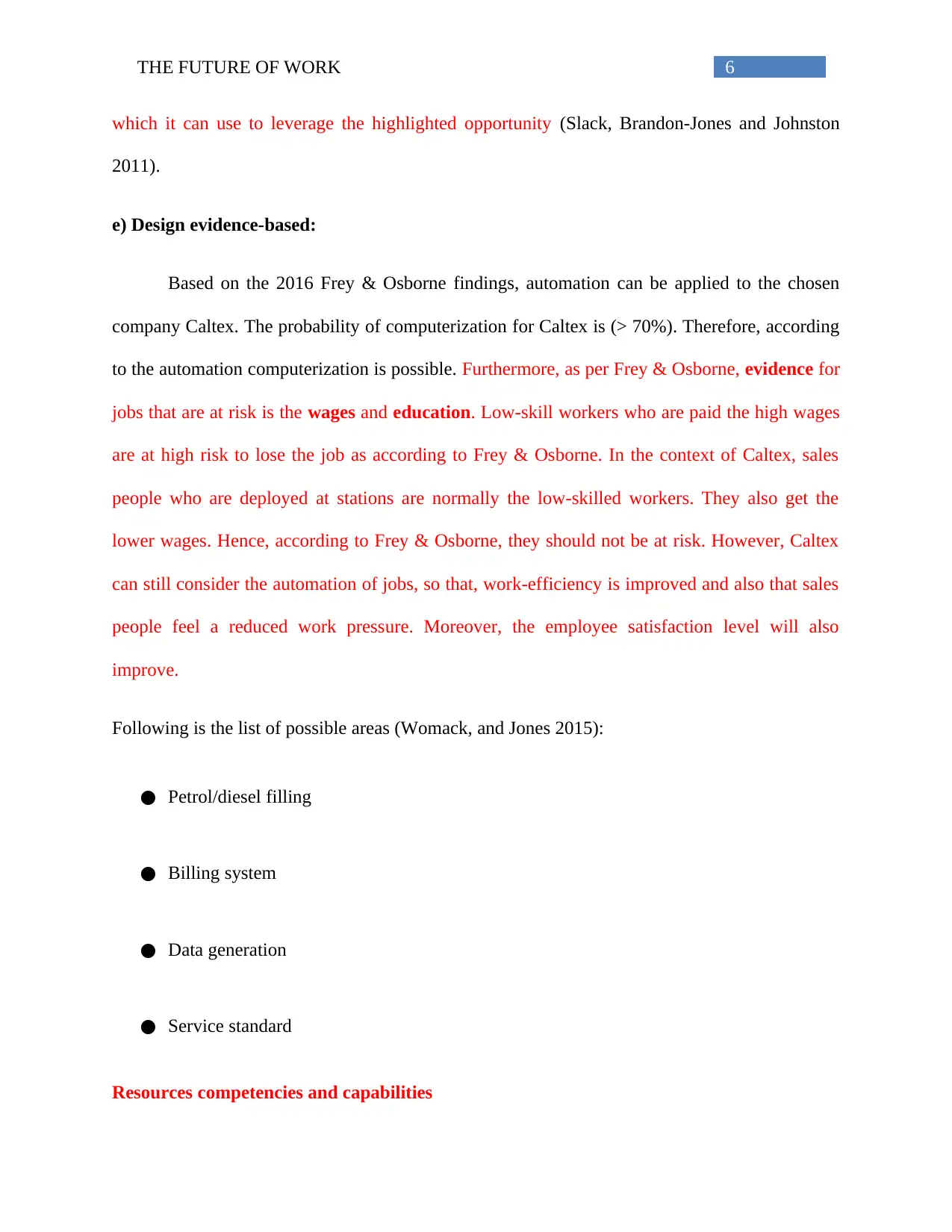
6THE FUTURE OF WORK
which it can use to leverage the highlighted opportunity (Slack, Brandon-Jones and Johnston
2011).
e) Design evidence-based:
Based on the 2016 Frey & Osborne findings, automation can be applied to the chosen
company Caltex. The probability of computerization for Caltex is (> 70%). Therefore, according
to the automation computerization is possible. Furthermore, as per Frey & Osborne, evidence for
jobs that are at risk is the wages and education. Low-skill workers who are paid the high wages
are at high risk to lose the job as according to Frey & Osborne. In the context of Caltex, sales
people who are deployed at stations are normally the low-skilled workers. They also get the
lower wages. Hence, according to Frey & Osborne, they should not be at risk. However, Caltex
can still consider the automation of jobs, so that, work-efficiency is improved and also that sales
people feel a reduced work pressure. Moreover, the employee satisfaction level will also
improve.
Following is the list of possible areas (Womack, and Jones 2015):
● Petrol/diesel filling
● Billing system
● Data generation
● Service standard
Resources competencies and capabilities
which it can use to leverage the highlighted opportunity (Slack, Brandon-Jones and Johnston
2011).
e) Design evidence-based:
Based on the 2016 Frey & Osborne findings, automation can be applied to the chosen
company Caltex. The probability of computerization for Caltex is (> 70%). Therefore, according
to the automation computerization is possible. Furthermore, as per Frey & Osborne, evidence for
jobs that are at risk is the wages and education. Low-skill workers who are paid the high wages
are at high risk to lose the job as according to Frey & Osborne. In the context of Caltex, sales
people who are deployed at stations are normally the low-skilled workers. They also get the
lower wages. Hence, according to Frey & Osborne, they should not be at risk. However, Caltex
can still consider the automation of jobs, so that, work-efficiency is improved and also that sales
people feel a reduced work pressure. Moreover, the employee satisfaction level will also
improve.
Following is the list of possible areas (Womack, and Jones 2015):
● Petrol/diesel filling
● Billing system
● Data generation
● Service standard
Resources competencies and capabilities
Paraphrase This Document
Need a fresh take? Get an instant paraphrase of this document with our AI Paraphraser
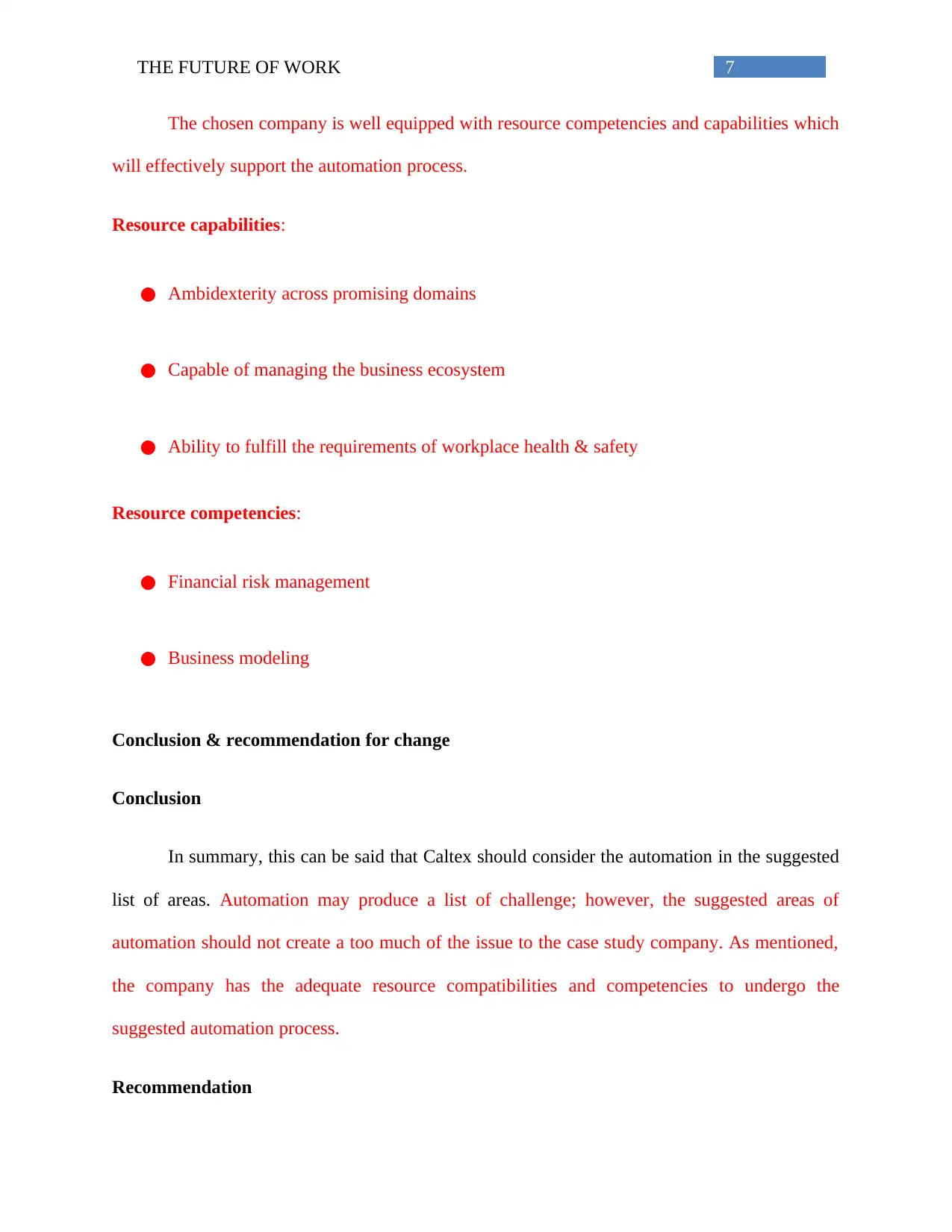
7THE FUTURE OF WORK
The chosen company is well equipped with resource competencies and capabilities which
will effectively support the automation process.
Resource capabilities:
● Ambidexterity across promising domains
● Capable of managing the business ecosystem
● Ability to fulfill the requirements of workplace health & safety
Resource competencies:
● Financial risk management
● Business modeling
Conclusion & recommendation for change
Conclusion
In summary, this can be said that Caltex should consider the automation in the suggested
list of areas. Automation may produce a list of challenge; however, the suggested areas of
automation should not create a too much of the issue to the case study company. As mentioned,
the company has the adequate resource compatibilities and competencies to undergo the
suggested automation process.
Recommendation
The chosen company is well equipped with resource competencies and capabilities which
will effectively support the automation process.
Resource capabilities:
● Ambidexterity across promising domains
● Capable of managing the business ecosystem
● Ability to fulfill the requirements of workplace health & safety
Resource competencies:
● Financial risk management
● Business modeling
Conclusion & recommendation for change
Conclusion
In summary, this can be said that Caltex should consider the automation in the suggested
list of areas. Automation may produce a list of challenge; however, the suggested areas of
automation should not create a too much of the issue to the case study company. As mentioned,
the company has the adequate resource compatibilities and competencies to undergo the
suggested automation process.
Recommendation
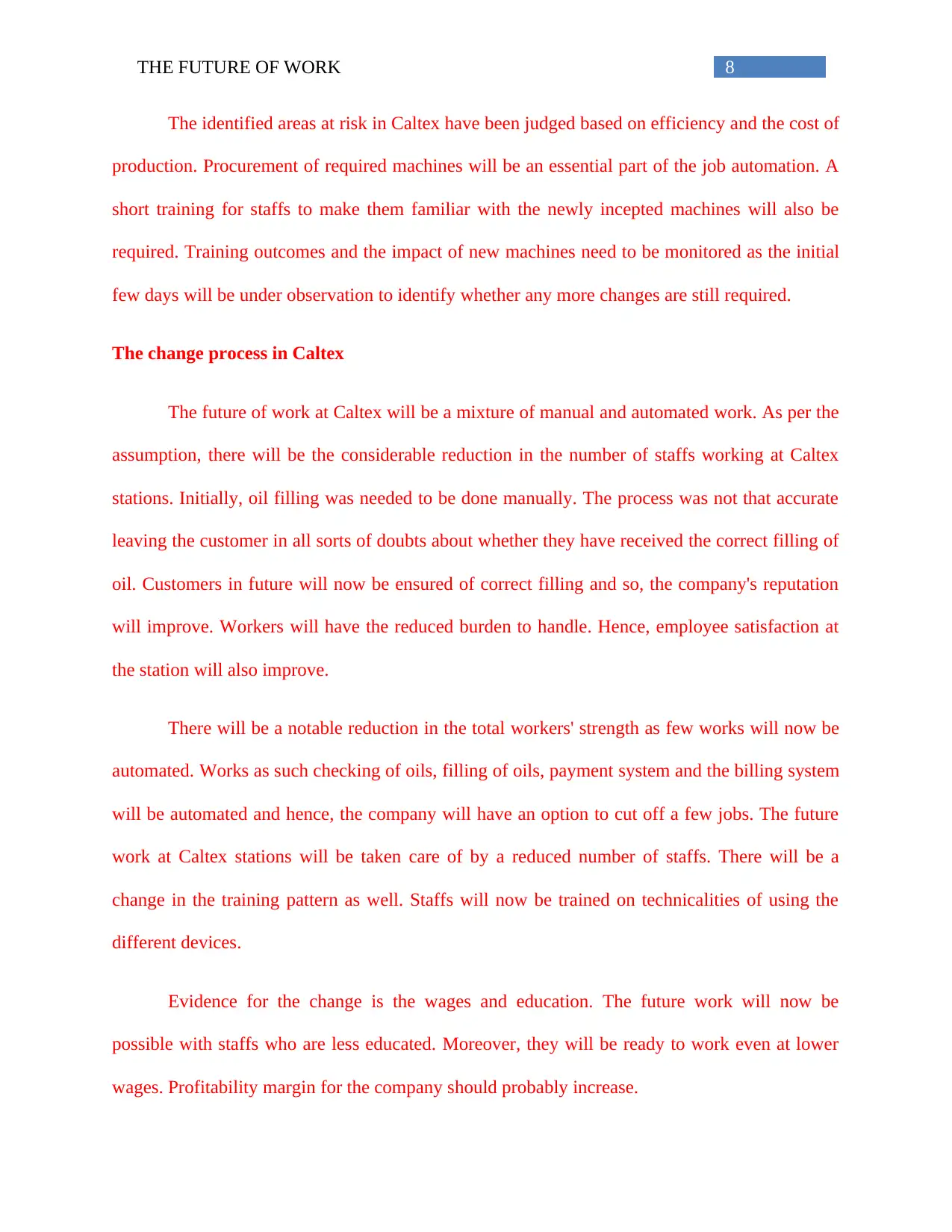
8THE FUTURE OF WORK
The identified areas at risk in Caltex have been judged based on efficiency and the cost of
production. Procurement of required machines will be an essential part of the job automation. A
short training for staffs to make them familiar with the newly incepted machines will also be
required. Training outcomes and the impact of new machines need to be monitored as the initial
few days will be under observation to identify whether any more changes are still required.
The change process in Caltex
The future of work at Caltex will be a mixture of manual and automated work. As per the
assumption, there will be the considerable reduction in the number of staffs working at Caltex
stations. Initially, oil filling was needed to be done manually. The process was not that accurate
leaving the customer in all sorts of doubts about whether they have received the correct filling of
oil. Customers in future will now be ensured of correct filling and so, the company's reputation
will improve. Workers will have the reduced burden to handle. Hence, employee satisfaction at
the station will also improve.
There will be a notable reduction in the total workers' strength as few works will now be
automated. Works as such checking of oils, filling of oils, payment system and the billing system
will be automated and hence, the company will have an option to cut off a few jobs. The future
work at Caltex stations will be taken care of by a reduced number of staffs. There will be a
change in the training pattern as well. Staffs will now be trained on technicalities of using the
different devices.
Evidence for the change is the wages and education. The future work will now be
possible with staffs who are less educated. Moreover, they will be ready to work even at lower
wages. Profitability margin for the company should probably increase.
The identified areas at risk in Caltex have been judged based on efficiency and the cost of
production. Procurement of required machines will be an essential part of the job automation. A
short training for staffs to make them familiar with the newly incepted machines will also be
required. Training outcomes and the impact of new machines need to be monitored as the initial
few days will be under observation to identify whether any more changes are still required.
The change process in Caltex
The future of work at Caltex will be a mixture of manual and automated work. As per the
assumption, there will be the considerable reduction in the number of staffs working at Caltex
stations. Initially, oil filling was needed to be done manually. The process was not that accurate
leaving the customer in all sorts of doubts about whether they have received the correct filling of
oil. Customers in future will now be ensured of correct filling and so, the company's reputation
will improve. Workers will have the reduced burden to handle. Hence, employee satisfaction at
the station will also improve.
There will be a notable reduction in the total workers' strength as few works will now be
automated. Works as such checking of oils, filling of oils, payment system and the billing system
will be automated and hence, the company will have an option to cut off a few jobs. The future
work at Caltex stations will be taken care of by a reduced number of staffs. There will be a
change in the training pattern as well. Staffs will now be trained on technicalities of using the
different devices.
Evidence for the change is the wages and education. The future work will now be
possible with staffs who are less educated. Moreover, they will be ready to work even at lower
wages. Profitability margin for the company should probably increase.
⊘ This is a preview!⊘
Do you want full access?
Subscribe today to unlock all pages.

Trusted by 1+ million students worldwide
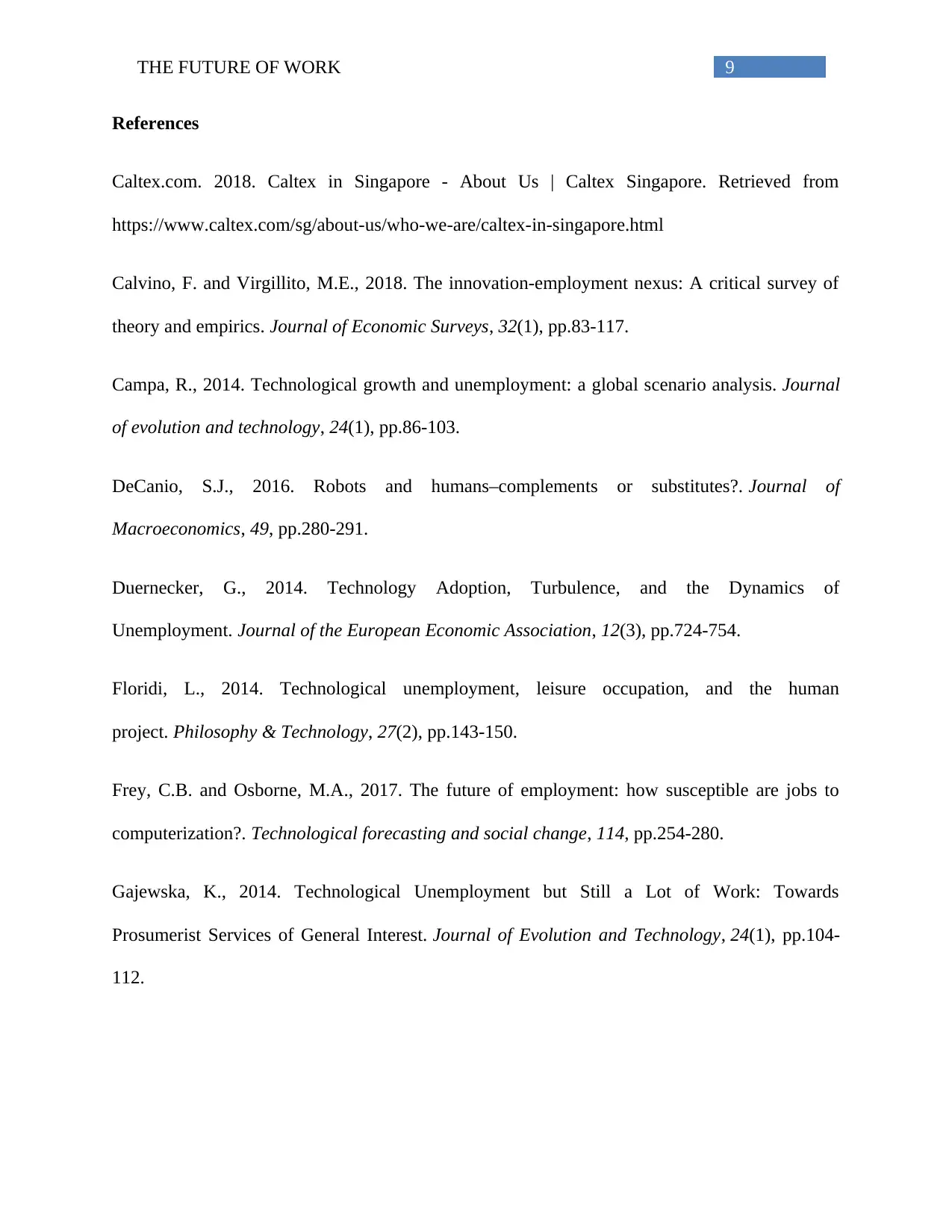
9THE FUTURE OF WORK
References
Caltex.com. 2018. Caltex in Singapore - About Us | Caltex Singapore. Retrieved from
https://www.caltex.com/sg/about-us/who-we-are/caltex-in-singapore.html
Calvino, F. and Virgillito, M.E., 2018. The innovation‐employment nexus: A critical survey of
theory and empirics. Journal of Economic Surveys, 32(1), pp.83-117.
Campa, R., 2014. Technological growth and unemployment: a global scenario analysis. Journal
of evolution and technology, 24(1), pp.86-103.
DeCanio, S.J., 2016. Robots and humans–complements or substitutes?. Journal of
Macroeconomics, 49, pp.280-291.
Duernecker, G., 2014. Technology Adoption, Turbulence, and the Dynamics of
Unemployment. Journal of the European Economic Association, 12(3), pp.724-754.
Floridi, L., 2014. Technological unemployment, leisure occupation, and the human
project. Philosophy & Technology, 27(2), pp.143-150.
Frey, C.B. and Osborne, M.A., 2017. The future of employment: how susceptible are jobs to
computerization?. Technological forecasting and social change, 114, pp.254-280.
Gajewska, K., 2014. Technological Unemployment but Still a Lot of Work: Towards
Prosumerist Services of General Interest. Journal of Evolution and Technology, 24(1), pp.104-
112.
References
Caltex.com. 2018. Caltex in Singapore - About Us | Caltex Singapore. Retrieved from
https://www.caltex.com/sg/about-us/who-we-are/caltex-in-singapore.html
Calvino, F. and Virgillito, M.E., 2018. The innovation‐employment nexus: A critical survey of
theory and empirics. Journal of Economic Surveys, 32(1), pp.83-117.
Campa, R., 2014. Technological growth and unemployment: a global scenario analysis. Journal
of evolution and technology, 24(1), pp.86-103.
DeCanio, S.J., 2016. Robots and humans–complements or substitutes?. Journal of
Macroeconomics, 49, pp.280-291.
Duernecker, G., 2014. Technology Adoption, Turbulence, and the Dynamics of
Unemployment. Journal of the European Economic Association, 12(3), pp.724-754.
Floridi, L., 2014. Technological unemployment, leisure occupation, and the human
project. Philosophy & Technology, 27(2), pp.143-150.
Frey, C.B. and Osborne, M.A., 2017. The future of employment: how susceptible are jobs to
computerization?. Technological forecasting and social change, 114, pp.254-280.
Gajewska, K., 2014. Technological Unemployment but Still a Lot of Work: Towards
Prosumerist Services of General Interest. Journal of Evolution and Technology, 24(1), pp.104-
112.
Paraphrase This Document
Need a fresh take? Get an instant paraphrase of this document with our AI Paraphraser
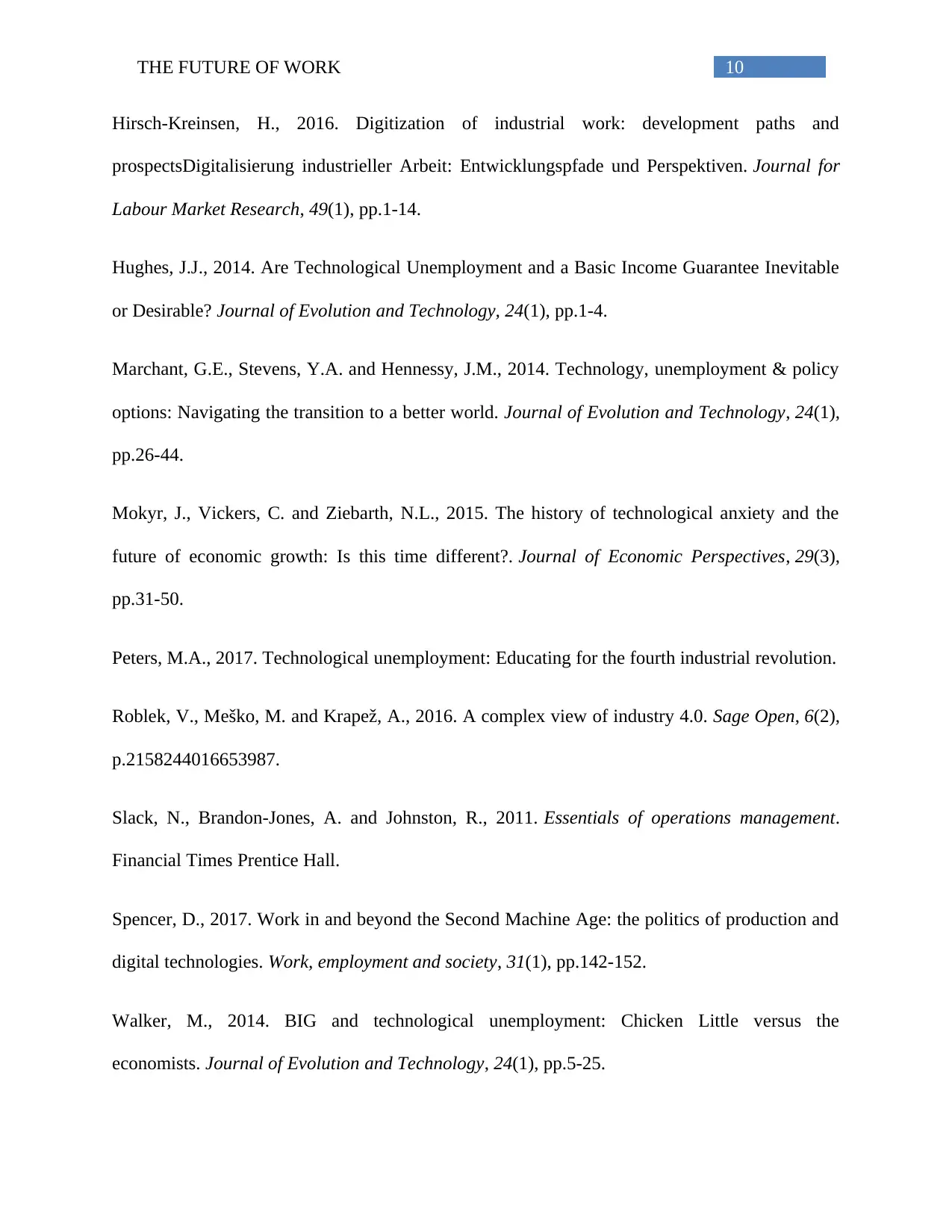
10THE FUTURE OF WORK
Hirsch-Kreinsen, H., 2016. Digitization of industrial work: development paths and
prospectsDigitalisierung industrieller Arbeit: Entwicklungspfade und Perspektiven. Journal for
Labour Market Research, 49(1), pp.1-14.
Hughes, J.J., 2014. Are Technological Unemployment and a Basic Income Guarantee Inevitable
or Desirable? Journal of Evolution and Technology, 24(1), pp.1-4.
Marchant, G.E., Stevens, Y.A. and Hennessy, J.M., 2014. Technology, unemployment & policy
options: Navigating the transition to a better world. Journal of Evolution and Technology, 24(1),
pp.26-44.
Mokyr, J., Vickers, C. and Ziebarth, N.L., 2015. The history of technological anxiety and the
future of economic growth: Is this time different?. Journal of Economic Perspectives, 29(3),
pp.31-50.
Peters, M.A., 2017. Technological unemployment: Educating for the fourth industrial revolution.
Roblek, V., Meško, M. and Krapež, A., 2016. A complex view of industry 4.0. Sage Open, 6(2),
p.2158244016653987.
Slack, N., Brandon-Jones, A. and Johnston, R., 2011. Essentials of operations management.
Financial Times Prentice Hall.
Spencer, D., 2017. Work in and beyond the Second Machine Age: the politics of production and
digital technologies. Work, employment and society, 31(1), pp.142-152.
Walker, M., 2014. BIG and technological unemployment: Chicken Little versus the
economists. Journal of Evolution and Technology, 24(1), pp.5-25.
Hirsch-Kreinsen, H., 2016. Digitization of industrial work: development paths and
prospectsDigitalisierung industrieller Arbeit: Entwicklungspfade und Perspektiven. Journal for
Labour Market Research, 49(1), pp.1-14.
Hughes, J.J., 2014. Are Technological Unemployment and a Basic Income Guarantee Inevitable
or Desirable? Journal of Evolution and Technology, 24(1), pp.1-4.
Marchant, G.E., Stevens, Y.A. and Hennessy, J.M., 2014. Technology, unemployment & policy
options: Navigating the transition to a better world. Journal of Evolution and Technology, 24(1),
pp.26-44.
Mokyr, J., Vickers, C. and Ziebarth, N.L., 2015. The history of technological anxiety and the
future of economic growth: Is this time different?. Journal of Economic Perspectives, 29(3),
pp.31-50.
Peters, M.A., 2017. Technological unemployment: Educating for the fourth industrial revolution.
Roblek, V., Meško, M. and Krapež, A., 2016. A complex view of industry 4.0. Sage Open, 6(2),
p.2158244016653987.
Slack, N., Brandon-Jones, A. and Johnston, R., 2011. Essentials of operations management.
Financial Times Prentice Hall.
Spencer, D., 2017. Work in and beyond the Second Machine Age: the politics of production and
digital technologies. Work, employment and society, 31(1), pp.142-152.
Walker, M., 2014. BIG and technological unemployment: Chicken Little versus the
economists. Journal of Evolution and Technology, 24(1), pp.5-25.

11THE FUTURE OF WORK
Womack, J.P. and Jones, D.T., 2015. Lean solutions: how companies and customers can create
value and wealth together. Simon and Schuster.
Womack, J.P. and Jones, D.T., 2015. Lean solutions: how companies and customers can create
value and wealth together. Simon and Schuster.
⊘ This is a preview!⊘
Do you want full access?
Subscribe today to unlock all pages.

Trusted by 1+ million students worldwide
1 out of 12
Related Documents
Your All-in-One AI-Powered Toolkit for Academic Success.
+13062052269
info@desklib.com
Available 24*7 on WhatsApp / Email
![[object Object]](/_next/static/media/star-bottom.7253800d.svg)
Unlock your academic potential
Copyright © 2020–2025 A2Z Services. All Rights Reserved. Developed and managed by ZUCOL.




